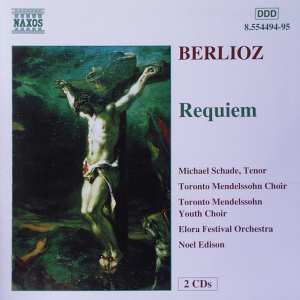|
Fever of excitement
ROBERT ANDERSON
examines Berlioz' Requiem in a new recording
|


To listen to the aural illustrations in this review, you may need to download
RealNetworks' realplayer G2.
|
The Berlioz Requiem was commissioned for performance in Les Invalides,
not yet final resting place of Napoleon, with mosaic fiction of the disastrous
Moscow campaign as a notable triumph. Yet the Requiem was to be the centrepiece
of an important state function, commemorating in 1837 the heroic dead of
the 1830 revolution. That was the original idea, but government manoeuvrings
deprived the July ceremony of opportunity for a major musical work.
Berlioz had already completed the Requiem, assembled the performers and
started rehearsals. Crisis in Algeria, a recurrent French phenonemon, providentially
came to his rescue. Casualties during the capture of the hill-top Constantine
in October included General Damremont, eminent enough to allow the Ministry
of War to revive the Messe des morts idea for 5 December. Berlioz
not only enjoyed a successful performance but relished the description of
it in his memoirs, particularly the moment when Habeneck, instead of indicating
clearly the tempo for the quartet of brass bands at the 'Tuba mirum', resorted
to a pinch of snuff.
Berlioz tackled the Requiem text in a fever of excitement. He reordered
the words, but at least he could spell them, which is more than can be said
for the compiler of the CD notes, where we have the Latin equivalent of
the 'Jundiciary singing huymns'. Berlioz's orchestral experiments in the
work are notorious. Sometimes they seem more remarkable than effective.
It must be said that Verdi's day of judgement, more economically achieved,
has greater impact than that of Berlioz, who is yet electrifying enough.
(Click to listen.) The composer's audacity in pitting
three flutes in the 'Hostias' and four in the 'Agnus Dei' against a lone
trombone excavated many octaves below creates intonation problems I defy
any conductor to solve. The effect suggests disconsolate wood-birds trying
in vain to reach accommodation with a grumpy Fafner. The quiet chords on
multiple timpani are again a wonder that raises the whole question of ends
and means.
But the Requiem gave Berlioz the chance of a lifetime, and he created
it with an intensity unusual even for him: 'My brain felt as though it would
explode with the pressure of ideas. The outline of one piece was barely
sketched before the next formed itself in my mind. It was impossible to
write fast enough, and I devised a sort of musical shorthand which was a
great help to me'.
 The choirs show considerable mastery of Berlioz's subtle and sinuous
lines. Only occasionally do the top sopranos quail slightly. The main criticism
of the choral singing must be the comparative weakness of the tenor lines,
whereas the basses are notably strong. Yet the start of the 'Quid sum miser'
(click to listen) gives an admirable idea
of what the tenors can manage by themselves, requested by Berlioz to sing
'with a feeling of humility and fear'. It must be considered a major achievement
that the quieter sections of the Requiem linger longest in the mind and
show the sensitivity of Noel Edison's approach. By contrast, the 'Rex tremendae'
with the incandescence Berlioz was after (click to listen).
The unaccompanied 'Quaerens me' is Berlioz at his most tender (click to listen) and here the Toronto singers balance admirably.
The Requiem has only one soloist, but Michael Schade's expressive tenor
in the 'Sanctus' is worth waiting for (click to listen).
Berlioz suggested the line might be sung by ten tenors in unison: Schade's
expansive lyricism would have banished such an alternative. Berlioz prized
the Requiem above his other works; I demur, but can certainly appreciate
a version as committed as this. The choirs show considerable mastery of Berlioz's subtle and sinuous
lines. Only occasionally do the top sopranos quail slightly. The main criticism
of the choral singing must be the comparative weakness of the tenor lines,
whereas the basses are notably strong. Yet the start of the 'Quid sum miser'
(click to listen) gives an admirable idea
of what the tenors can manage by themselves, requested by Berlioz to sing
'with a feeling of humility and fear'. It must be considered a major achievement
that the quieter sections of the Requiem linger longest in the mind and
show the sensitivity of Noel Edison's approach. By contrast, the 'Rex tremendae'
with the incandescence Berlioz was after (click to listen).
The unaccompanied 'Quaerens me' is Berlioz at his most tender (click to listen) and here the Toronto singers balance admirably.
The Requiem has only one soloist, but Michael Schade's expressive tenor
in the 'Sanctus' is worth waiting for (click to listen).
Berlioz suggested the line might be sung by ten tenors in unison: Schade's
expansive lyricism would have banished such an alternative. Berlioz prized
the Requiem above his other works; I demur, but can certainly appreciate
a version as committed as this.
Copyright © Robert Anderson,
July 24th 1999
BERLIOZ REQUIEM
Michael Schade, tenor
Toronto Mendelssohn Choir and Youth Choir
Elora Festival Orchestra
Noel Edison, conductor
Recorded at the Cathedral of the Transfiguration,
Markham, Ontario, Canada, 8 - 11 November 1998
Producers: Norman Kraft, Bonnie Silver
Engineer: Ed Marshall
Naxos 8.554494-95
(2 CDs) DDD 86'16
Copyright © 1999 HNH International Ltd.
ORDER THIS CD FROM CROTCHET |
<< Music &
Vision homepage More CD reviews >>
|